Advancements in Micro-LED Performance through Nanomaterials and Nanostructures: A Review
Abstract
:1. Introduction
2. Principle
2.1. Non-Radiative Energy Transfer (NRET)
2.2. Localized Surface Plasmon Resonance (LSPR)
3. Using Nanomaterials to Enhance μLED Luminous Efficiency and Color Conversion Efficiency
3.1. Metal Nanoparticles (NPs)
3.1.1. Using Ag NPs to Enhance Luminous Efficiency
3.1.2. Using Ag NPs to Enhance Color Conversion Efficiency
3.2. TiO2 Nanoparticles
4. Using Nanostructures to Enhance μLED Luminous Efficiency and Color Conversion Efficiency
4.1. Nanoring Structures
4.1.1. Using Nanorings to Enhance Luminous Efficiency
4.1.2. Using Nanorings to Enhance Color Conversion Efficiency
4.2. Nanohole Structure
4.2.1. Using Nanoholes to Enhance Luminous Efficiency
4.2.2. Using Nanoholes to Enhance Color Conversion Efficiency
4.3. Nanorod Structure
4.3.1. Using Nanorods to Enhance Luminous Efficiency
4.3.2. Using Nanorods to Enhance Color Conversion Efficiency
5. Challenges and Prospects
Author Contributions
Funding
Data Availability Statement
Conflicts of Interest
References
- Lee, T.-Y.; Chen, L.-Y.; Lo, Y.-Y.; Swayamprabha, S.S.; Kumar, A.; Huang, Y.-M.; Chen, S.-C.; Zan, H.-W.; Chen, F.-C.; Horng, R.-H.; et al. Technology and Applications of Micro-LEDs: Their Characteristics, Fabrication, Advancement, and Challenges. ACS Photonics 2022, 9, 3017–3026. [Google Scholar] [CrossRef]
- Ding, K.; Avrutin, V.; Izyumskaya, N.; Özgür, Ü.; Morkoç, H. Micro-LEDs, a Manufacturability Perspective. Appl. Sci. 2019, 9, 1206. [Google Scholar] [CrossRef]
- Parbrook, P.J.; Corbett, B.; Han, J.; Seong, T.-Y.; Amano, H. Micro-Light Emitting Diode: From Chips to Applications. Laser Photonics Rev. 2021, 15, 2000133. [Google Scholar] [CrossRef]
- Chiou, E. TrendForce 2023 Micro LED Market Trend and Technology Cost Analysis; TrendForce: Taipei City, China, 2023; Available online: https://www.trendforce.com/research/download/RP231130BR (accessed on 30 November 2023).
- Zhou, X.; Tian, P.; Sher, C.-W.; Wu, J.; Liu, H.; Liu, R.; Kuo, H.-C. Growth, transfer printing and colour conversion techniques towards full-colour micro-LED display. Prog. Quantum Electron. 2020, 71, 100263. [Google Scholar] [CrossRef]
- Park, S.-C.; Fang, J.; Biswas, S.; Mozafari, M.; Stauden, T.; Jacobs, H.O. A First Implementation of an Automated Reel-to-Reel Fluidic Self-Assembly Machine. Adv. Mater. 2014, 26, 5942–5949. [Google Scholar] [CrossRef]
- Yoon, J.; Lee, S.-M.; Kang, D.; Meitl, M.A.; Bower, C.A.; Rogers, J.A. Heterogeneously Integrated Optoelectronic Devices Enabled by Micro-Transfer Printing. Adv. Opt. Mater. 2015, 3, 1313–1335. [Google Scholar] [CrossRef]
- Gandrothula, S.; Kamikawa, T.; Shapturenka, P.; Anderson, R.; Wong, M.; Zhang, H.; Speck, J.S.; Nakamura, S.; Denbaars, S.P. Optical and electrical characterizations of micro-LEDs grown on lower defect density epitaxial layers. Appl. Phys. Lett. 2021, 119, 142103. [Google Scholar] [CrossRef]
- Olivier, F.; Tirano, S.; Dupré, L.; Aventurier, B.; Largeron, C.; Templier, F. Influence of size-reduction on the performances of GaN-based micro-LEDs for display application. J. Lumin. 2017, 191, 112–116. [Google Scholar] [CrossRef]
- Liou, J.C.; Yang, C.F. Design and fabrication of micro-LED array with application-specific integrated circuits (ASICs) light emitting display. Microsyst. Technol. 2018, 24, 4089–4099. [Google Scholar] [CrossRef]
- Horng, R.-H.; Chen, Y.-F.; Wang, C.-H.; Chen, H.-Y. Development of Metal Bonding for Passive Matrix Micro-LED Display Applications. IEEE Electron Device Lett. 2021, 42, 1017–1020. [Google Scholar] [CrossRef]
- Li, P.; Zhang, X.; Qi, L.; Lau, K.M. Full-color micro-display by heterogeneous integration of InGaN blue/green dual-wavelength and AlGaInP red LEDs. Opt. Express 2022, 30, 23499–23510. [Google Scholar] [CrossRef] [PubMed]
- Ahmed, K. Micro LED Display: Technology and Manufacturing Challenges. SPIE Proc. 2021, 11610, 1161003. [Google Scholar] [CrossRef]
- Hang, S.; Chuang, C.-M.; Zhang, Y.; Chu, C.; Tian, K.; Zheng, Q.; Wu, T.; Liu, Z.; Zhang, Z.-H.; Li, Q.; et al. A review on the low external quantum efficiency and the remedies for GaN-based micro-LEDs. J. Phys. D Appl. Phys. 2021, 54, 153002. [Google Scholar] [CrossRef]
- Xu, F.; Tao, T.; Zhang, D.; Zhang, Y.; Sang, Y.; Yu, J.; Zhi, T.; Zhuang, Z.; Xie, Z.; Zhang, R.; et al. Wafer-Scale Monolithic Integration of Blue Micro-Light-Emitting Diodes and Green/Red Quantum Dots for Full-Color Displays. IEEE Electron Device Lett. 2023, 44, 1320–1323. [Google Scholar] [CrossRef]
- Han, L.; Ogier, S.; Li, J.; Sharkey, D.; Yin, X.; Baker, A.; Carreras, A.; Chang, F.; Cheng, K.; Guo, X. Wafer-scale organic-on-III-V monolithic heterogeneous integration for active-matrix micro-LED displays. Nat. Commun. 2023, 14, 6985. [Google Scholar] [CrossRef] [PubMed]
- Qi, L.; Li, P.; Zhang, X.; Wong, K.M.; Lau, K.M. Monolithic full-color active-matrix micro-LED micro-display using InGaN/AlGaInP heterogeneous integration. Light. Sci. Appl. 2023, 12, 258. [Google Scholar] [CrossRef] [PubMed]
- Han, H.-V.; Lin, H.-Y.; Lin, C.-C.; Chong, W.-C.; Li, J.-R.; Chen, K.-J.; Yu, P.; Chen, T.-M.; Chen, H.-M.; Lau, K.-M.; et al. Resonant-enhanced full-color emission of quantum-dot-based μLED display technology. Opt. Express 2015, 23, 32504–32515. [Google Scholar] [CrossRef]
- Kou, J.; Shen, C.C.; Shao, H.; Che, J.; Hou, X.; Chu, C.; Tian, K.; Zhang, Y.; Zhang, Z.H.; Kuo, H.C. Impact of the surface recombination on InGaN/GaN-based blue micro-light emitting diodes. Opt. Express 2019, 27, A643–A653. [Google Scholar] [CrossRef] [PubMed]
- Horng, R.-H.; Ye, C.-X.; Chen, P.-W.; Iida, D.; Ohkawa, K.; Wu, Y.-R.; Wuu, D.-S. Study on the effect of size on InGaN red micro-LEDs. Sci. Rep. 2022, 12, 1324. [Google Scholar] [CrossRef]
- Wang, X.; Zhao, X.; Takahashi, T.; Ohori, D.; Samukawa, S. 3.5 × 3.5 μm2 GaN blue micro-light-emitting diodes with negligible sidewall surface nonradiative recombination. Nat. Commun. 2023, 14, 7569. [Google Scholar] [CrossRef]
- Bulashevich, K.A.; Kulik, A.V.; Karpov, S.Y. Optimal ways of colour mixing for high-quality white-light LED sources. Phys. Status Solidi A 2015, 212, 914–919. [Google Scholar] [CrossRef]
- Hwang, D.; Mughal, A.; Pynn, C.D.; Nakamura, S.; DenBaars, S.P. Sustained high external quantum efficiency in ultrasmall blue III–nitride micro-LEDs. Appl. Phys. Express 2017, 10, 032101. [Google Scholar] [CrossRef]
- Hou, M.; Wang, H.; Miao, Y.; Xu, H.; Guo, Z.; Chen, Z.; Liao, X.; Li, L.; Li, J.; Guo, K. Highly Efficient Deep-Blue Electroluminescence from a A−π–D−π–A Structure Based Fluoresence Material with Exciton Utilizing Efficiency above 25%. ACS Appl. Energy Mater. 2018, 1, 3243–3254. [Google Scholar] [CrossRef]
- Huang, Y.; Hsiang, E.-L.; Deng, M.-Y.; Wu, S.-T. Mini-LED, Micro-LED and OLED displays: Present status and future perspectives. Light. Sci. Appl. 2020, 9, 105. [Google Scholar] [CrossRef]
- Ponce, F.; Bour, D. Nitride-based semiconductors for blue and green light-emitting devices. Nature 1997, 386, 351–359. [Google Scholar] [CrossRef]
- Fujii, T.; Gao, Y.; Sharma, R.; Hu, E.L.; DenBaars, S.P.; Nakamura, S. Increase in the extraction efficiency of GaN-based light-emitting diodes via surface roughening. Appl. Phys. Lett. 2004, 84, 855–857. [Google Scholar] [CrossRef]
- Xu, K.; Xu, C.; Xie, Y.; Deng, J.; Zhu, Y.; Guo, W.; Mao, M.; Xun, M.; Chen, M.; Zheng, L.; et al. GaN nanorod light emitting diodes with suspended graphene transparent electrodes grown by rapid chemical vapor deposition. Appl. Phys. Lett. 2013, 103, 222105. [Google Scholar] [CrossRef]
- Ke, M.-Y.; Wang, C.-Y.; Chen, L.-Y.; Chen, H.-H.; Chiang, H.-L.; Cheng, Y.-W.; Hsieh, M.-Y.; Chen, C.-P.; Huang, J.-J. Application of Nanosphere Lithography to LED Surface Texturing and to the Fabrication of Nanorod LED Arrays. IEEE J. Sel. Top. Quantum Electron. 2009, 15, 1242–1249. [Google Scholar] [CrossRef]
- Tsai, S.-C.; Lu, C.-H.; Liu, C.-P. Piezoelectric effect on compensation of the quantum-confined Stark effect in InGaN/GaN multiple quantum wells based green light-emitting diodes. Nano Energy 2016, 28, 373–379. [Google Scholar] [CrossRef]
- Chan, C.C.S.; Reid, B.P.L.; Taylor, R.A.; Zhuang, Y.; Shields, P.A.; Allsopp, D.W.E.; Jia, W. Optical studies of the surface effects from the luminescence of single GaN/InGaN nanorod light emitting diodes fabricated on a wafer scale. Appl. Phys. Lett. 2013, 102, 129–2214. [Google Scholar] [CrossRef]
- Zhang, S.; Zhang, J.; Gao, J.; Wang, X.; Zheng, C.; Zhang, M.; Wu, X.; Xu, L.; Ding, J.; Quan, Z.; et al. Efficient emission of InGaN-based light-emitting diodes: Toward orange and red. Photon. Res. 2020, 8, 1671–1675. [Google Scholar] [CrossRef]
- Fan, K.; Tao, J.; Zhao, Y.; Li, P.; Sun, W.; Zhu, L.; Lv, J.; Qin, Y.; Wang, Q.; Liang, J.; et al. Size effects of AlGaInP red vertical micro-LEDs on silicon substrate. Results Phys. 2022, 36, 105449. [Google Scholar] [CrossRef]
- Pandey, A.; Min, J.; Reddeppa, M.; Malhotra, Y.; Xiao, Y.; Wu, Y.; Sun, K.; Mi, Z. An Ultrahigh Efficiency Excitonic Micro-LED. Nano Lett. 2023, 23, 1680–1687. [Google Scholar] [CrossRef] [PubMed]
- Wang, S.W.; Hong, K.B.; Tsai, Y.L.; Teng, C.H.; Tzou, A.J.; Chu, Y.C.; Lee, P.T.; Ku, P.C.; Lin, C.C.; Kuo, H.C. Wavelength tunable InGaN/GaN nano-ring LEDs via nano-sphere lithography. Sci. Rep. 2017, 7, 42962. [Google Scholar] [CrossRef] [PubMed]
- Mei, Y.; Xie, M.; Yang, T.; Hou, X.; Ou, W.; Long, H.; Ying, L.; Liu, Y.; Weng, G.; Chen, S.; et al. Improvement of the Emission Intensity of GaN-Based Micro-Light Emitting Diodes by a Suspended Structure. ACS Photonics 2022, 9, 3967–3973. [Google Scholar] [CrossRef]
- Fadila, A.; Ou, Y.; Iida, D.; Kamiyama, S.; Petersen, P.M.; Ou, H. Combining surface plasmonic and light extraction enhancement on InGaN quantum-well light-emitters. Nanoscale 2016, 8, 16340. [Google Scholar] [CrossRef] [PubMed]
- Du, Z.; Feng, H.; Liu, Y.; Tang, P.; Qian, F.; Sun, J.; Guo, W.; Song, J.; Chen, E.; Guo, T.; et al. Localized surface plasmon coupling nanorods with graphene as a transparent conductive electrode for micro light-emitting diodes. IEEE Electron Device Lett. 2022, 43, 2133–2136. [Google Scholar] [CrossRef]
- Wang, X.; Tian, Z.; Zhang, M.; Li, Q.; Su, X.; Zhang, Y.; Hu, P.; Li, Y.; Yun, F. Enhanced coupling efficiency and electrical property in surface plasmon-enhanced light-emitting diodes with the tapered Ag structure. Opt. Express 2020, 28, 35708–35715. [Google Scholar] [CrossRef]
- Huang, Y.-Y.; Li, Z.-H.; Lai, Y.-C.; Chen, J.-C.; Wu, S.-H.; Yang, S.; Kuo, Y.; Yang, C.-C.; Hsu, T.-C.; Lee, C.-L. Nanoscale-cavity enhancement of color conversion with colloidal quantum dots embedded in the surface nano-holes of a blue-emitting light-emitting diode. Opt. Express 2022, 30, 31322–31335. [Google Scholar] [CrossRef]
- Chen, H.; Shen, C.; Wu, T.; Liao, Z.; Chen, L.; Zhou, J.; Lee, C.; Lin, C.; Lin, C.; Sher, C.; et al. Full-color monolithic hybrid quantum dot nanoring micro light-emitting diodes with improved efficiency using atomic layer deposition and nonradiative resonant energy transfer. Photonics Res. 2019, 7, 416–422. [Google Scholar] [CrossRef]
- Du, Z.; Wang, K.; Sun, J.; Guo, W.; Wu, C.; Lin, C.; Yan, Q. Ultrahigh color conversion efficiency nano-light-emitting diode with single electrical contact. IEEE Trans. Electron Devices 2023, 70, 1156–1161. [Google Scholar] [CrossRef]
- Wang, Y.-T.; Liu, C.-W.; Chen, P.-Y.; Wu, R.-N.; Ni, C.-C.; Cai, C.-J.; Kiang, Y.-W.; Yang, C.C. Color conversion efficiency enhancement of colloidal quantum dot through its linkage with synthesized metal nanoparticle on a blue light-emitting diode. Opt. Lett. 2019, 44, 5691–5694. [Google Scholar] [CrossRef]
- Zhang, X.; Hu, H.; Qie, Y.; Lin, L.; Guo, T.; Li, F. Boosting the Efficiency of High-Resolution Quantum Dot Light-Emitting Devices Based on Localized Surface Plasmon Resonance. ACS Appl. Mater. Interfaces 2024, 16, 13219–13224. [Google Scholar] [CrossRef] [PubMed]
- Hyun, B.-R.; Sher, C.-W.; Chang, Y.-W.; Lin, Y.; Liu, Z.; Kuo, H.-C. Dual Role of Quantum Dots as Color Conversion Layer and Suppression of Input Light for Full-Color Micro-LED Displays. J. Phys. Chem. Lett. 2021, 12, 6946–6954. [Google Scholar] [CrossRef] [PubMed]
- Achermann, M.; Petruska, M.; Kos, S.; Smith, D.L.; Koleske, D.D.; Klimov, V.I. Energy-transfer pumping of semiconductor nanocrystals using an epitaxial quantum well. Nature 2004, 429, 642–646. [Google Scholar] [CrossRef]
- Chanyawadee, S.; Lagoudakis, P.G.; Harley, R.T.; Charlton, M.D.B.; Talapin, D.V.; Huang, H.W.; Lin, C.-H. Increased Color-Conversion Efficiency in Hybrid Light-Emitting Diodes utilizing Non-Radiative Energy Transfer. Adv. Mater. 2010, 22, 602–606. [Google Scholar] [CrossRef] [PubMed]
- Achermann, M.; Petruska, M.A.; Koleske, D.D.; Crawford, M.H.; Klimov, V.I. Nanocrystal-Based Light-Emitting Diodes Utilizing High-Efficiency Nonradiative Energy Transfer for Color Conversion. Nano Lett. 2006, 6, 1396–1400. [Google Scholar] [CrossRef]
- Krishnan, C.; Brossard, M.; Lee, K.-Y.; Huang, J.-K.; Lin, C.-H.; Kuo, H.-C.; Charlton, M.D.B.; Lagoudakis, P.G. Hybrid photonic crystal light-emitting diode renders 123% color conversion effective quantum yield. Optica 2016, 3, 503–509. [Google Scholar] [CrossRef]
- Ghataora, S.; Smith, R.M.; Athanasiou, M.; Wang, T. Electrically Injected Hybrid Organic/Inorganic III-Nitride White Light-Emitting Diodes with Nonradiative Förster Resonance Energy Transfer. ACS Photonics 2018, 5, 642–647. [Google Scholar] [CrossRef]
- Zhang, F.; Liu, J.; You, G.; Zhang, C.; Mohney, S.E.; Park, M.J.; Kwak, J.S.; Wang, Y.; Koleske, D.D.; Xu, J. Nonradiative energy transfer between colloidal quantum dot-phosphors and nanopillar nitride LEDs. Opt. Express 2012, 20, A333–A339. [Google Scholar] [CrossRef]
- Zhuang, Z.; Guo, X.; Liu, B.; Hu, F.; Li, Y.; Tao, T.; Dai, J.; Zhi, T.; Xie, Z.; Chen, P.; et al. High Color Rendering Index Hybrid III-Nitride/Nanocrystals White Light-Emitting Diodes. Adv. Funct. Mater. 2016, 26, 36–43. [Google Scholar] [CrossRef]
- Pons, T.; Medintz, I.L.; Sapsford, K.E.; Higashiya, S.; Grimes, A.F.; English, D.S.; Mattoussi, H. On the Quenching of Semi-conductor Quantum Dot Photoluminescence by Proximal Gold Nanoparticles. Nano Lett. 2007, 7, 3157–3164. [Google Scholar] [CrossRef] [PubMed]
- Sahoo, H. Förster resonance energy transfer–A spectroscopic nanoruler: Principle and applications. J. Photochem. Photobiol. C Photochem. Rev. 2011, 12, 20–30. [Google Scholar] [CrossRef]
- Krishnan, C.; Mercier, T.; Rahman, T.; Piana, G.; Brossard, M.; Yagafarov, T.; To, A.; Pollard, M.E.; Shaw, P.; Bagnall, D.M. Efficient light harvesting in hybrid quantum dot–interdigitated back contact solar cells via resonant energy transfer and luminescent downshifting. Nanoscale 2019, 11, 18837–18844. [Google Scholar] [CrossRef] [PubMed]
- Okamoto, K.; Niki, I.; Scherer, A.; Narukawa, Y.; Mukai, T.; Kawakami, Y. Surface plasmon enhanced spontaneous emission rate of quantum wells probed by time-resolved photoluminescence spectroscopy. Appl. Phys. Lett. 2005, 87, 071102. [Google Scholar] [CrossRef]
- Gao, N.; Huang, K.; Li, J.; Li, S.; Yang, X.; Kang, J. Surface-plasmon-enhanced deep-UV light emitting diodes based on AlGaN multi-quantum wells. Sci. Rep. 2012, 2, 816. [Google Scholar] [CrossRef] [PubMed]
- Shi, Z.; Li, Y.; Li, S.; Li, X.; Wu, D.; Xu, T.; Tian, Y.; Chen, Y.; Zhang, Y.; Zhang, B.; et al. Localized Surface Plasmon Enhanced All-Inorganic Perovskite Quantum Dot Light-Emitting Diodes Based on Coaxial Core/Shell Heterojunction Architecture. Adv. Funct. Mater. 2018, 28, 1707031. [Google Scholar] [CrossRef]
- Sanz, J.M.; Ortiz, D.; Osa, R.A.; Saiz, J.M.; González, F.; Brown, A.S.; Losurdo, M.; Everitt, H.O.; Moreno, F. UV Plasmonic Behavior of Various Metal Nanoparticles in the Near- and Far-Field Regimes: Geometry and Substrate Effects. J. Phys. Chem. C 2013, 117, 19606–19615. [Google Scholar] [CrossRef]
- Barnes, W.L. Turning the Tables on Surface Plasmons. Nature 2004, 3, 588–589. [Google Scholar] [CrossRef]
- Zhang, S.; He, R.; Duo, Y.; Chen, R.; Wang, L.; Wang, J.; Wei, T. Plasmon-enhanced deep ultraviolet Micro-LED arrays for solar-blind communications. Opt. Lett. 2023, 48, 3841–3844. [Google Scholar] [CrossRef]
- Jiang, N.; Chen, Y.; Lv, B.; Jiang, K.; Zhang, S.; Lu, S.; Li, S.; Tao, T.; Sun, X.; Li, D. Plasmonic-enhanced efficiency of AlGaN-based deep ultraviolet LED by graphene/Al nanoparticles/graphene hybrid structure. Opt. Lett. 2023, 48, 3175–3178. [Google Scholar] [CrossRef] [PubMed]
- Cheng, W.C.; Huang, S.Y.; Chen, Y.J.; Wang, C.S.; Lin, H.Y.; Wu, T.M.; Horng, R.H. AlGaInP red LEDs with hollow hemi-spherical polystyrene arrays. Sci. Rep. 2018, 8, 911. [Google Scholar] [CrossRef] [PubMed]
- Zhan-Xu, C.; Wei, W.; Ying-Ji, H.; Geng-Yan, C.; Yong-Zhu, C. Light-extraction enhancement of GaN-based LEDs by closely-packed nanospheres monolayer. Acta Phys. Sin. 2015, 64, 148502. [Google Scholar] [CrossRef]
- Du, Z.; Sun, J.; Feng, H.; Tang, P.; Guo, W.; Han, K.; Chen, E.; Guo, T.; Song, J.; Yan, Q. Efficiency enhancement of micro-light-emitting diode with shrinking size by localized surface plasmons coupling. Appl. Phys. B 2024, 130, 36. [Google Scholar] [CrossRef]
- Chang, W.-M.; Huang, J.-J.; Yao, Y.-F.; Kiang, Y.-W.; Yang, C.-C. Emission Efficiency Dependence on the p-GaN Thickness in a High Indium InGaN/GaN Quantum-Well Light-Emitting Diode. IEEE Photon. Technol. Lett. 2011, 23, 1757–1759. [Google Scholar] [CrossRef]
- Cho, I.S.; Chen, Z.; Forman, A.J.; Kim, D.R.; Rao, P.M.; Jaramillo, T.F.; Zheng, X. Branched TiO2 Nanorods for Photoelectrochemical Hydrogen Production. Nano Lett. 2011, 11, 4978–4984. [Google Scholar] [CrossRef] [PubMed]
- Hossain, M.K.; Kitahama, Y.; Huang, G.G.; Han, X.; Ozaki, Y. Surface-enhanced Raman scattering: Realization of localized surface plasmon resonance using unique substrates and methods. Anal. Bioanal. Chem. 2009, 394, 1747–1760. [Google Scholar] [CrossRef] [PubMed]
- Kim, S.-K.; Lee, S.-H.; Yoon, S.-Y.; Jo, D.-Y.; Kim, H.-M.; Kim, Y.; Park, S.M.; Yang, H. Localized surface plasmon-enhanced blue electroluminescent device based on ZnSeTe quantum dots and AuAg nanoparticles. Inorg. Chem. Front. 2022, 9, 3138–3147. [Google Scholar] [CrossRef]
- Wang, B.Z.; Chua, S.J. Enhanced light output from light emitting diodes with two-dimensional cone-shape nanostructured surface. J. Vac. Sci. Technol. B 2013, 31, 032205. [Google Scholar] [CrossRef]
- Yang, Y.; Zheng, Y.; Cao, W.; Titov, A.; Hyvonen, J.; Manders, J.R.; Xue, J.; Holloway, P.H.; Qian, L. High-efficiency light-emitting devices based on quantum dots with tailored nanostructures. Nat. Photon. 2015, 9, 259–266. [Google Scholar] [CrossRef]
- Kim, H.-M.; Cho, Y.-H.; Lee, H.; Kim, S.I.; Ryu, S.R.; Kim, D.Y.; Kang, T.W.; Chung, K.S. High-Brightness Light Emitting Diodes Using Dislocation-Free Indium Gallium Nitride/Gallium Nitride Multiquantum-Well Nanorod Arrays. Nano Lett. 2004, 4, 1059–1062. [Google Scholar] [CrossRef]
- Chen, H.-S.; Yeh, D.-M.; Lu, Y.-C.; Chen, C.-Y.; Huang, C.-F.; Tang, T.-Y.; Yang, C.C.; Wu, C.-S.; Chen, C.-D. Strain relaxation and quantum confinement in InGaN/GaN nanoposts. Nanotechnology 2006, 17, 1454–1458. [Google Scholar] [CrossRef]
- Li, Z.; Kang, J.; Zhang, Y.; Liu, Z.; Wang, L.; Lee, X.; Li, X.; Yi, X.; Zhu, H.; Wang, G. The fabrication of GaN-based nanorod light-emitting diodes with multilayer graphene transparent electrodes. J. Appl. Phys. 2013, 113, 234302. [Google Scholar] [CrossRef]
- Chen, L.-Y.; Huang, Y.-Y.; Chang, C.-H.; Sun, Y.-H.; Cheng, Y.-W.; Ke, M.-Y.; Chen, C.-P.; Huang, J. High performance InGaN/GaN nanorod light emitting diode arrays fabricated by nanosphere lithography and chemical mechanical polishing processes. Opt. Express 2010, 18, 7664–7669. [Google Scholar] [CrossRef] [PubMed]
- Li, Q.; Westlake, K.R.; Crawford, M.H.; Lee, S.R.; Koleske, D.D.; Figiel, J.J.; Cross, K.C.; Fathololoumi, S.; Mi, Z.; Wang, G.T. Optical performance of top-down fabricated InGaN/GaN nanorod light emitting diode arrays. Opt. Express 2011, 19, 25528–25534. [Google Scholar] [CrossRef] [PubMed]
- Bae, S.-Y.; Kong, D.-J.; Lee, J.-Y.; Seo, D.-J.; Lee, D.-S. Size-controlled InGaN/GaN nanorod array fabrication and optical characterization. Opt. Express 2013, 21, 16854–16862. [Google Scholar] [CrossRef] [PubMed]
- Nakashima, S.; Sugioka, K.; Ito, T.; Takai, H.; Midorikawa, K. Fabrication of periodic nano-hole array on GaN surface by fs laser for improvement of extraction efficiency in blue LED. Phys. Procedia 2010, 5A, 203–211. [Google Scholar] [CrossRef]
- Kuo, Y.; Yang, C.C. Theoretical/Numerical Studies of the Nanoscale-Cavity Effects on Dipole Emission, Förster Resonance Energy Transfer, and Surface Plasmon Coupling. Plasmonics 2024, 19, 273–285. [Google Scholar] [CrossRef]
- Poirier-Richard, H.-P.; Couture, M.; Brule, T.; Masson, J.-F. Metal-enhanced fluorescence and FRET on nanohole arrays excited at angled incidence. Analyst 2015, 140, 4792–4798. [Google Scholar] [CrossRef]
- Purcell, E.M. Spontaneous Emission Probabilities at Radio Frequencies. In Confined Electrons and Photons; Burstein, E., Weisbuch, C., Eds.; NATO ASI Series; Springer: Boston, MA, USA, 1995; Volume 340, Chapter 40. [Google Scholar] [CrossRef]
- Qi, Y.D.; Liang, H.; Wang, D.; Lu, Z.D.; Tang, W.; Lau, K.M. Comparison of blue and green InGaN/GaN multiple-quantum-well light-emitting diodes grown by metalorganic vapor phase epitaxy. Appl. Phys. Lett. 2005, 86, 101903. [Google Scholar] [CrossRef]
- Tateishi, K.; Wang, P.; Ryuzaki, S.; Funato, M.; Kawakami, Y.; Okamoto, K.; Tamada, K. Micro-photoluminescence mapping of surface plasmon enhanced light emissions from InGaN/GaN quantum wells. Appl. Phys. Lett. 2017, 111, 172105. [Google Scholar] [CrossRef]
- Sun, L.; Zhang, S.; Liu, F.; Han, M. Influence of localized surface plasmons on carrier dynamics in InGaN/GaN quantum wells covered with Ag nanoparticles for enhanced photoluminescence. Superlattices Microstruct. 2015, 86, 418–424. [Google Scholar] [CrossRef]
- Cho, C.-Y.; Park, S.-J. Enhanced optical output and reduction of the quantum-confined Stark effect in surface plasmon-enhanced green light-emitting diodes with gold nanoparticles. Opt. Express 2016, 24, 7488. [Google Scholar] [CrossRef] [PubMed]
- Du, Z.; Chen, E.; Feng, H.; Qian, F.; Xiong, F.; Tang, P.; Guo, W.; Song, J.; Yan, Q.; Guo, T.; et al. Efficiency improvement of GaN-based micro-light-emitting diodes embedded with Ag NPs into a periodic arrangement of nano-hole channel structure by ultra close range localized surface plasmon coupling. Nanotechnology 2022, 33, 495202. [Google Scholar] [CrossRef] [PubMed]
- Du, Z.; Li, D.; Guo, W.; Xiong, F.; Tang, P.; Zhou, X.; Zhang, Y.; Guo, T.; Yan, Q.; Sun, J. Quantum Dot Color Conversion Efficiency Enhancement in Micro-Light-Emitting Diodes by Non-Radiative Energy Transfer. IEEE Electron Device Lett. 2021, 42, 1184–1187. [Google Scholar] [CrossRef]
- Song, J.; Kang, J.-h.; Han, J. Monolithic RGB Micro-Light-Emitting Diodes Fabricated with Quantum Dots Embedded inside Nanoporous GaN. ACS Appl. Electron. Mater. 2021, 3, 4877–4881. [Google Scholar] [CrossRef]
- Muskens, O.L.; Rivas, J.G.; Algra, R.E.; Bakkers, E.P.A.M.; Lagendijk, A. Design of Light Scattering in Nanowire Materials for Photovoltaic Applications. Nano Lett. 2008, 8, 2638–2642. [Google Scholar] [CrossRef]
- Muskens, O.L.; Diedenhofen, S.L.; Kaas, B.C.; Algra, R.E.; Bakkers, E.P.A.M.; Gómez Rivas, J.; Lagendijk, A. Large Photonic Strength of Highly Tunable Resonant Nanowire Materials. Nano Lett. 2009, 9, 930–934. [Google Scholar] [CrossRef] [PubMed]
- Zhuang, Z.; Li, C.; Zhang, Y.; Liu, B.; Zhang, X.; Fan, A.; Chen, S.; Lu, L.; Cui, Y. Influence of plasmonic resonant wavelength on energy transfer from an InGaN quantum well to quantum dots. Appl. Phys. Lett. 2021, 118, 202103. [Google Scholar] [CrossRef]
- Yang, S.; Lai, Y.-C.; Feng, H.-Y.; Lee, Y.-C.; Li, Z.-H.; Wu, S.-H.; Lin, Y.-S.; Hsieh, H.-Y.; Chu, C.-J.; Chen, W.-C.; et al. Enhanced Color Conversion of Quantum Dots Located in the Hot Spot of Surface Plasmon Coupling. IEEE Photonics Technol. Lett. 2023, 35, 273–276. [Google Scholar] [CrossRef]
- Chen, C.-H.; Kuo, S.-Y.; Feng, H.-Y.; Li, Z.-H.; Yang, S.; Wu, S.-H.; Hsieh, H.-Y.; Lin, Y.-S.; Lee, Y.-C.; Chen, W.-C.; et al. Photon color conversion enhancement of colloidal quantum dots inserted into a subsurface laterally-extended GaN nano-porous structure in an InGaN/GaN quantum-well template. Opt. Express 2023, 31, 6327–6341. [Google Scholar] [CrossRef] [PubMed]
- Bavencove, A.-L.; Tourbot, G.; Garcia, J.; Désières, Y.; Gilet, P.; Levy, F.; André, B.; Gayral, B.; Daudin, B.; Dang, L.S. Submicrometre resolved optical characterization of green nanowire-based light emitting diodes. Nanotechnology 2011, 22, 345705. [Google Scholar] [CrossRef] [PubMed]
- Yu, Z.-G.; Zhao, L.-X.; Wei, X.-C.; Wang, J.-X.; Li, J.-M. Influence of SiO2 or SiNx passivation on the electrical properties of GaN-based nanorod LEDs. In Proceedings of the 2013 10th China International Forum on Solid State Lighting (ChinaSSL), Beijing, China, 10–12 November 2013; pp. 291–294. [Google Scholar] [CrossRef]
- Bavencove, A.-L.; Tourbot, G.; Pougeoise, E.; Garcia, J.; Gilet, P.; Levy, F.; André, B.; Feuillet, G.; Gayral, B.; Daudin, B.; et al. GaN-based nanowires: From nanometric-scale characterization to light emitting diodes. Phys. Stat. Sol. A 2010, 207, 1425–1427. [Google Scholar] [CrossRef]
- Kim, S.-U.; Um, D.-Y.; Oh, J.-K.; Chandran, B.; Lee, C.-R.; Ra, Y.-H. Structural Engineering in a Microscale Laser Diode with InGaN Tunnel-Junction Nanorods. ACS Photonics 2023, 10, 1053–1059. [Google Scholar] [CrossRef]
- Kotlyar, K.P.; Morozov, I.A.; Shubina, K.Y.; Berezovskaya, T.N.; Dragunova, A.S.; Kryzhanovskaya, N.V.; Kudryashov, D.A.; Lihachev, A.I.; Nashchekin, A.V.; Soshnikov, I.P.; et al. InGaN/GaN QDs nanorods for light emitters: Processing and properties. AIP Conf. Proc. 2019, 2064, 030006. [Google Scholar] [CrossRef]
- Wang, K.; Liu, Y.; Chen, R.; Wu, C.; Zhou, X.; Zhang, Y.; Liu, Z.; Guo, T. Light-Pulse Splitting from Nano-Light-Emitting Diodes Operating in Noncarrier Injection Mode. IEEE Electron Device Lett. 2021, 42, 1033–1036. [Google Scholar] [CrossRef]
- Wang, K.; Chen, P.; Chen, J.; Liu, Y.; Wu, C.; Sun, J.; Zhou, X.; Zhang, Y.; Guo, T. Alternating current electroluminescence from GaN-based nanorod light-emitting diodes. Opt. Laser Technol. 2021, 140, 107044. [Google Scholar] [CrossRef]
- Zhang, D.; Xu, F.; Sang, Y.; Yu, J.; Tao, T.; Zhuang, Z.; Zhi, T.; Yan, Y.; Liu, B.; Zhang, R.; et al. Dominant Mechanism of GaN-Based Single Contact Micro-LED Driven by AC Power. IEEE Electron Device Lett. 2023, 44, 468–471. [Google Scholar] [CrossRef]
- Wang, K.; Li, W.; Chen, R.; Zhang, Y.; Zhou, X.; Ye, Y.; Guo, T.; Wu, C. High-Density LED Array Based on Epitaxial Slice Damage-Free Process and Its Single-Contact Operation Mode with Low Crosstalk. IEEE Electron Device Lett. 2023, 44, 1865–1868. [Google Scholar] [CrossRef]
- Koester, R.; Sager, D.; Quitsch, W.-A.; Pfingsten, O.; Poloczek, A.; Blumenthal, S.; Keller, G.; Prost, W.; Bacher, G.; Tegude, F.-J. High-Speed GaN/GaInN Nanowire Array Light-Emitting Diode on Silicon(111). Nano Lett. 2015, 15, 2318–2323. [Google Scholar] [CrossRef]
- Jeon, D.; Choi, W.M.; Shin, H.; Yoon, S.; Choi, J.; Jang, L.; Lee, I. Nanopillar InGaN/GaN light emitting diodes integrated with homogeneous multilayer graphene electrodes. J. Mater. Chem. 2011, 21, 17688. [Google Scholar] [CrossRef]
- Li, Z.-T.; Song, C.-J.; Du, X.-W.; Xuan, J.; Li, J.-S.; Tang, Y. Study on the Photoluminescence Intensity, Thermal Performance, and Color Purity of Quantum Dot Light-Emitting Diodes Using a Pumping-Light Absorber. IEEE Trans. Electron. Devices 2020, 67, 2418–2424. [Google Scholar] [CrossRef]
- Elahi, A.M.N.; Pei, Z.; Yu, P.; Xu, J. Thermal and Photochemical Stability Studies of Color-Converted MicroLED Microdisplay Panels. IEEE Photonics J. 2023, 15, 1–6. [Google Scholar] [CrossRef]
- Huang, Y.-M.; Singh, K.J.; Liu, A.-C.; Lin, C.-C.; Chen, Z.; Wang, K.; Lin, Y.; Liu, Z.; Wu, T.; Kuo, H.-C. Advances in Quantum-Dot-Based Displays. Nanomaterials 2020, 10, 1327. [Google Scholar] [CrossRef]
- Anwar, A.R.; Sajjad, M.T.; Johar, M.A.; Hernández-Gutiérrez, C.A.; Usman, M.; Łepkowski, S.P. Recent Progress in Micro-LED-Based Display Technologies. Laser Photonics Rev. 2022, 16, 2100427. [Google Scholar] [CrossRef]
- Saito, T.; Hasegawa, N.; Imura, K.; Suehiro, Y.; Takeuchi, T.; Kamiyama, S.; Iida, D.; Ohkawa, K.; Iwaya, M. RGB monolithic GaInN-based μLED arrays connected via tunnel junctions. Appl. Phys. Express 2023, 16, 084001. [Google Scholar] [CrossRef]
- Shin, J.; Kim, H.; Sundaram, S.; Jeong, J.; Park, B.-I.; Chang, C.S.; Choi, J.; Kim, T.; Saravanapavanantham, M.; Lu, K.; et al. Vertical full-colour micro-LEDs via 2D materials-based layer transfer. Nature 2023, 614, 81–87. [Google Scholar] [CrossRef] [PubMed]
- Shan, X.; Zhu, S.; Qiu, P.; Qian, Z.; Lin, R.; Wang, Z.; Cui, X.; Liu, R.; Tian, P. Multifunctional Ultraviolet-C Micro-LED With Monolithically Integrated Photodetector for Optical Wireless Communication. J. Light. Technol. 2022, 40, 490–498. [Google Scholar] [CrossRef]
- Lin, R.; Jin, Z.; Qiu, P.; Liao, Y.; Hoo, J.; Guo, S.; Cui, X.; Tian, P. High bandwidth series-biased green micro-LED array toward 6 Gbps visible light communication. Opt. Lett. 2022, 47, 3343–3346. [Google Scholar] [CrossRef]
- Wei, Z.; Li, M.; Liu, Z.; Wang, Z.; Zhang, C.; Chen, C.-J.; Wu, M.-C.; Yang, Y.; Yu, C.; Fu, H.Y. Parallel Mini/Micro-LEDs Transmitter: Size-Dependent Effect and Gbps Multi-User Visible Light Communication. J. Light. Technol. 2022, 40, 2329–2340. [Google Scholar] [CrossRef]
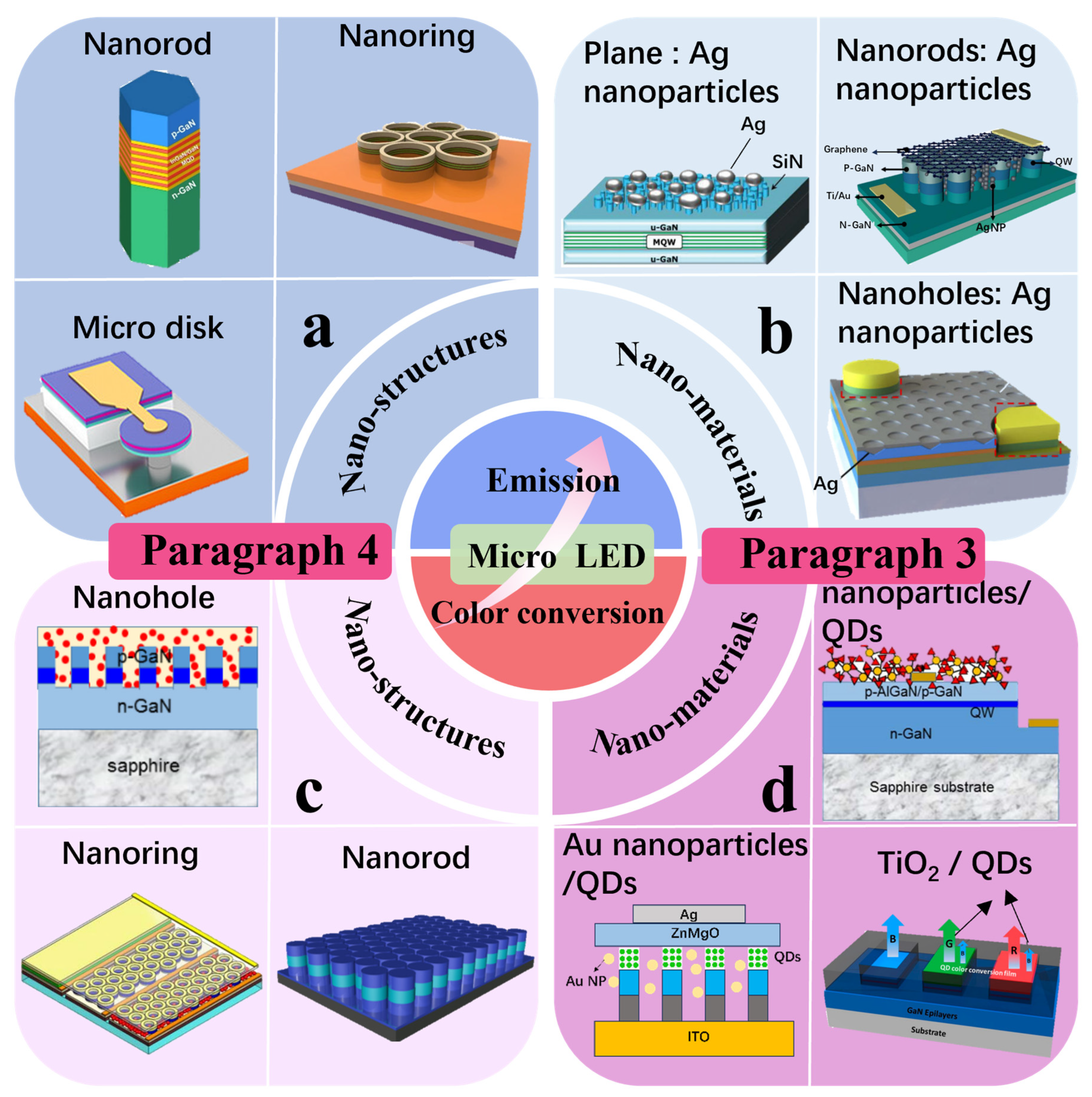
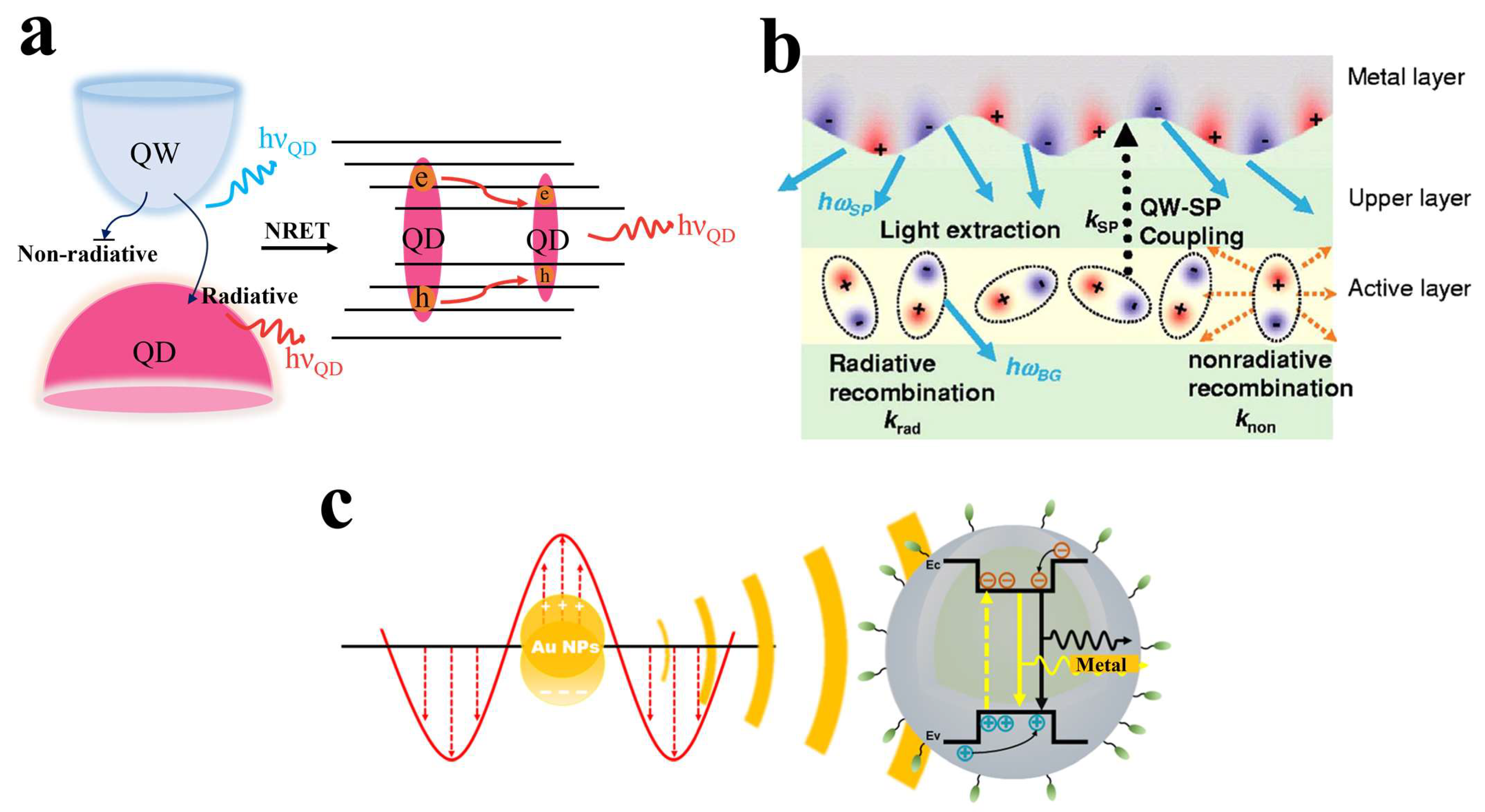



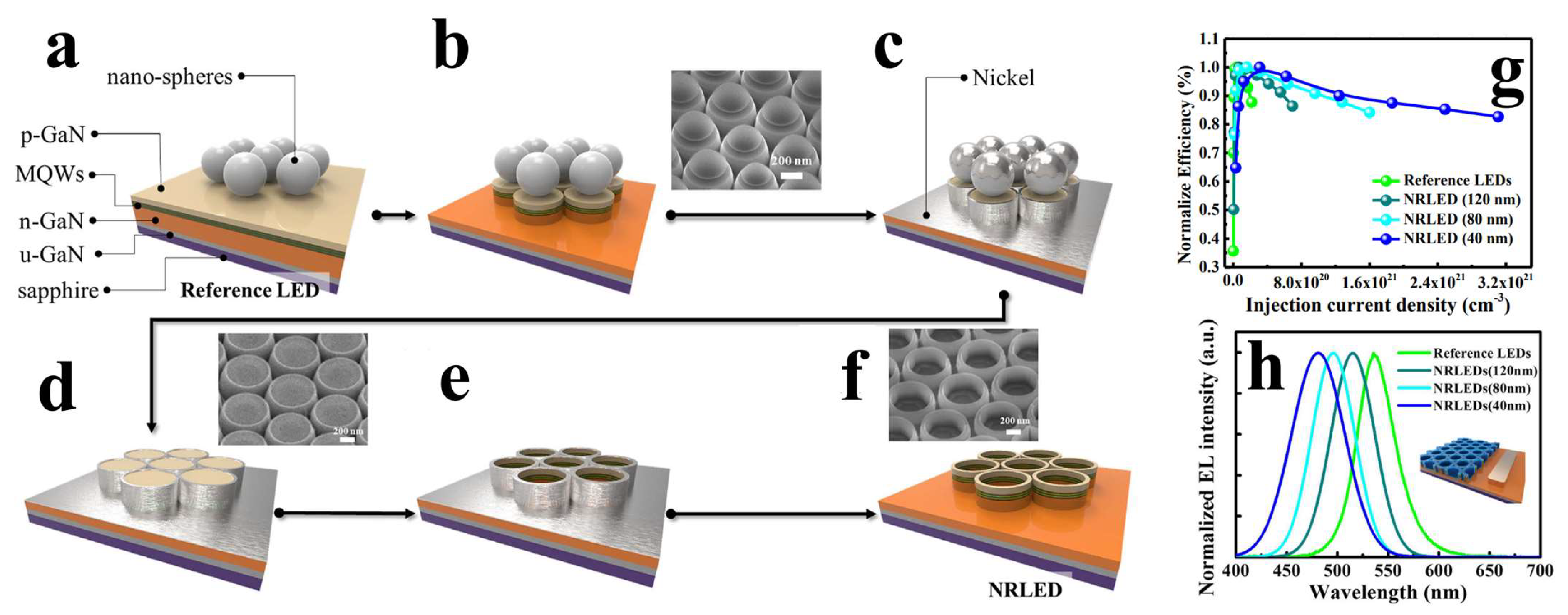
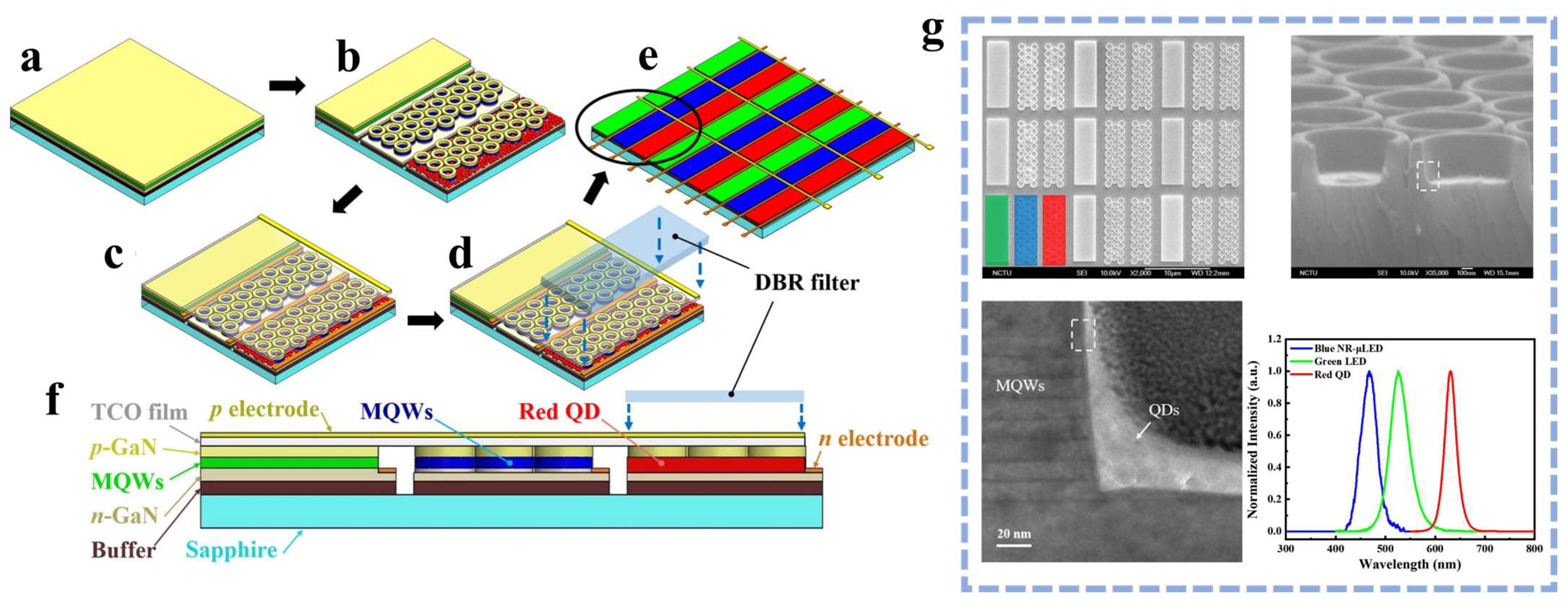


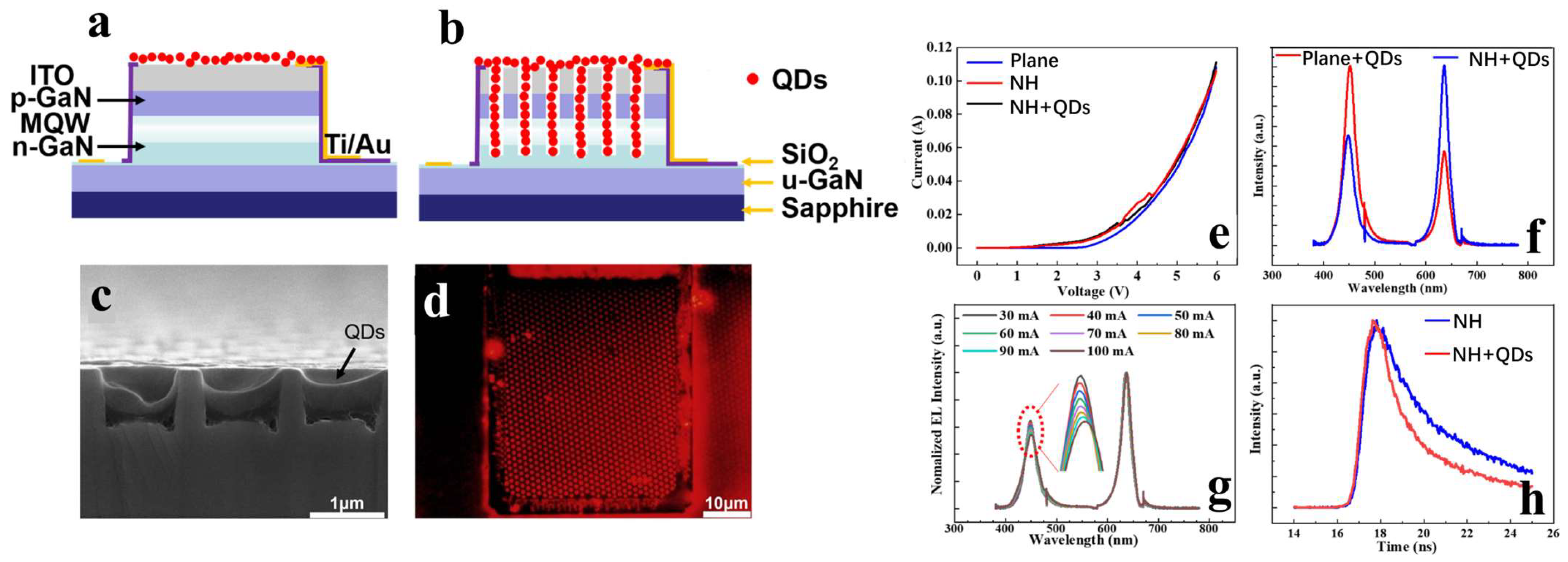
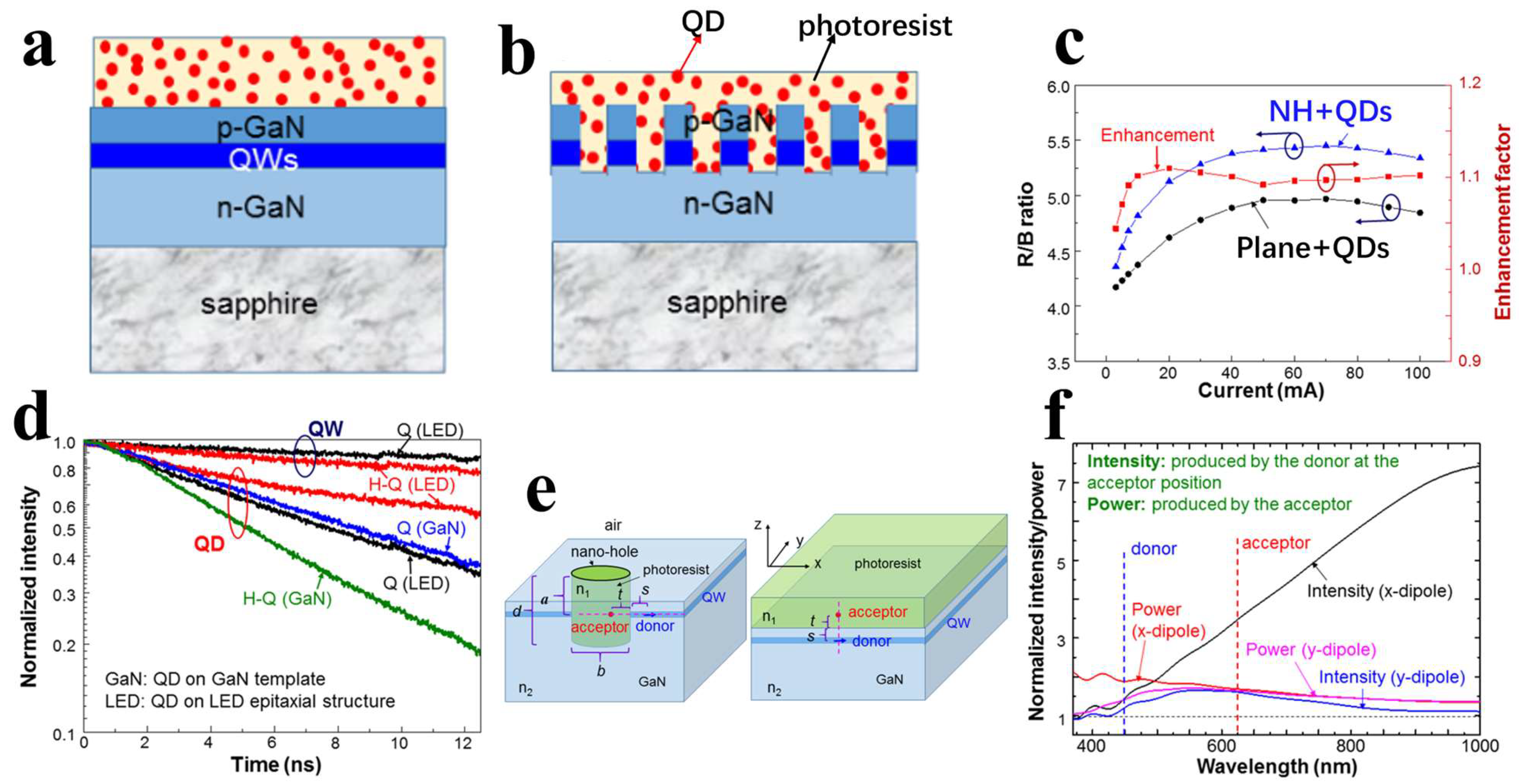
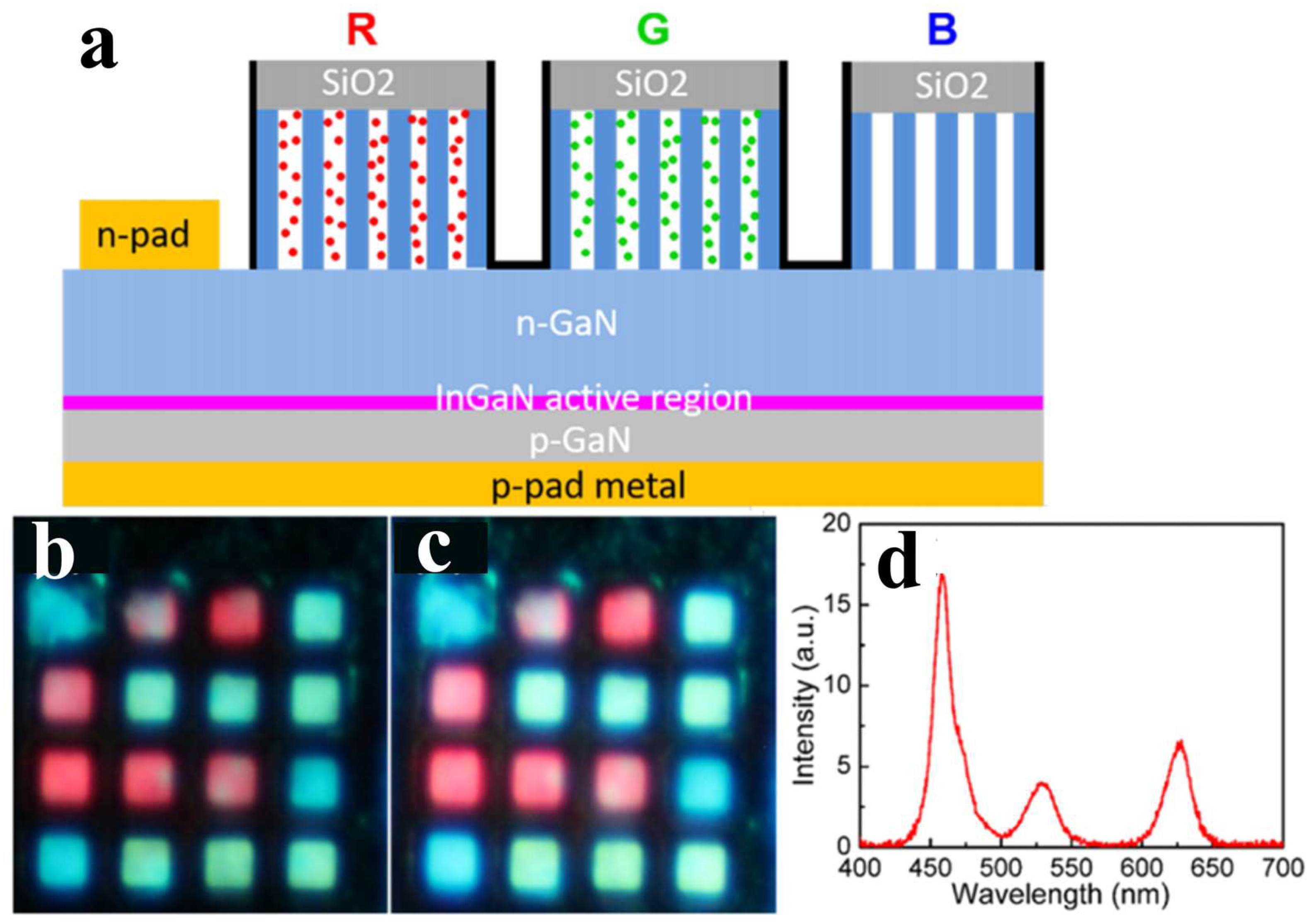
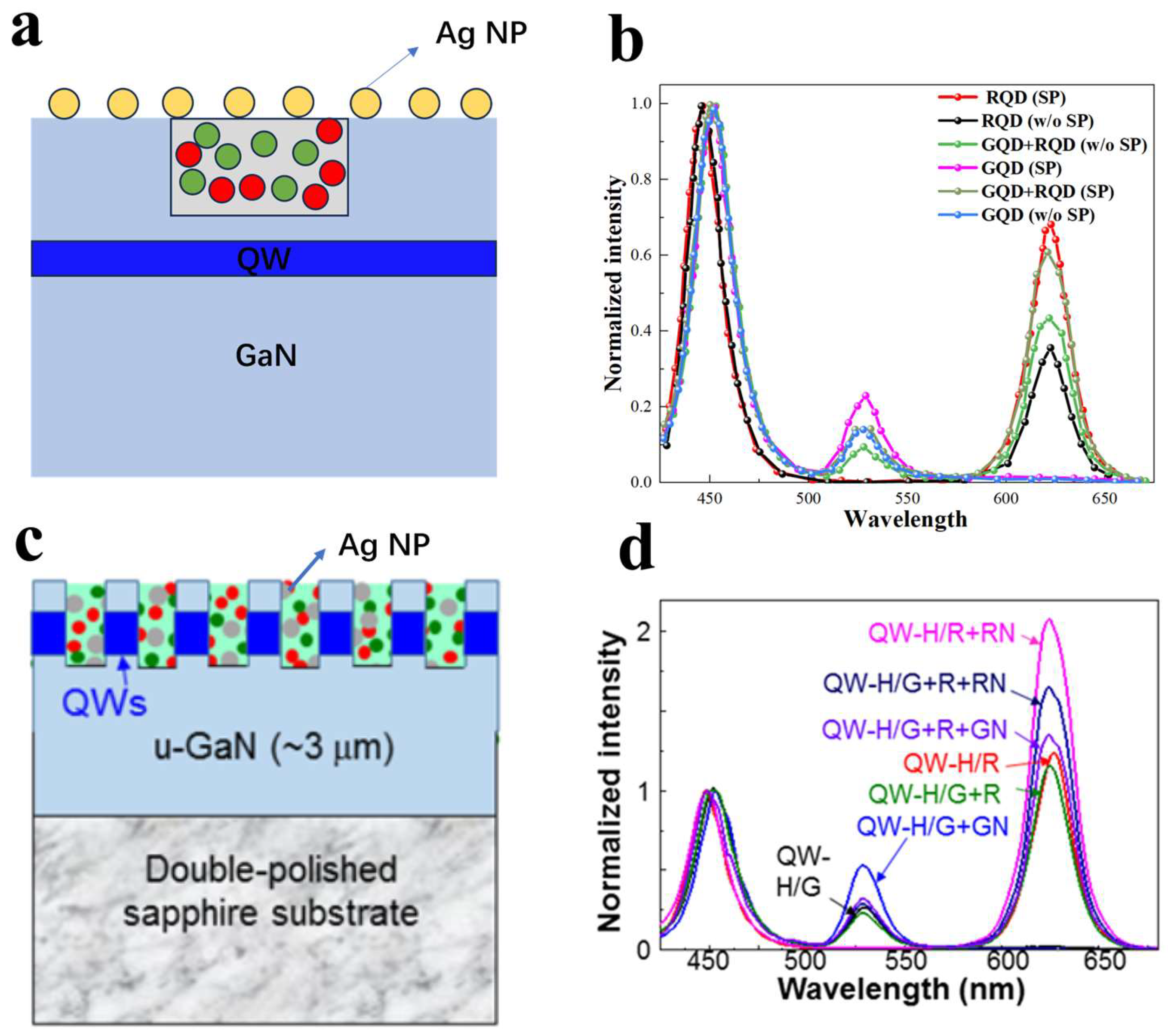
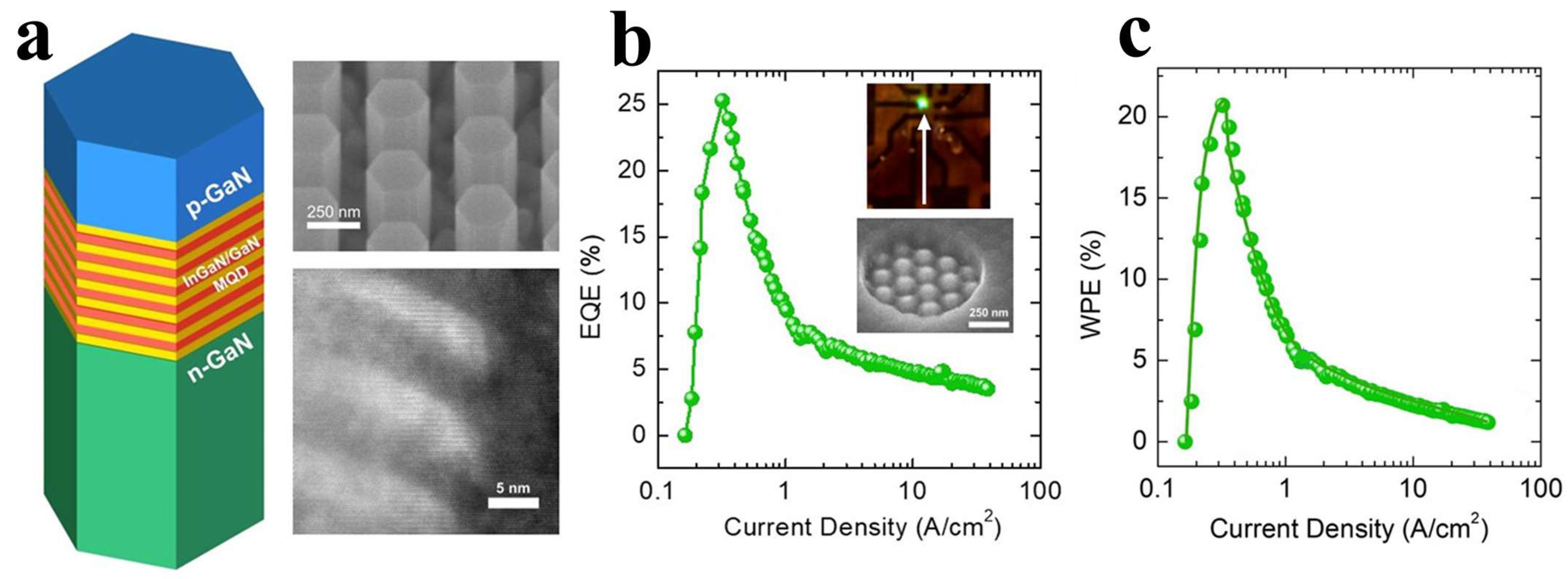
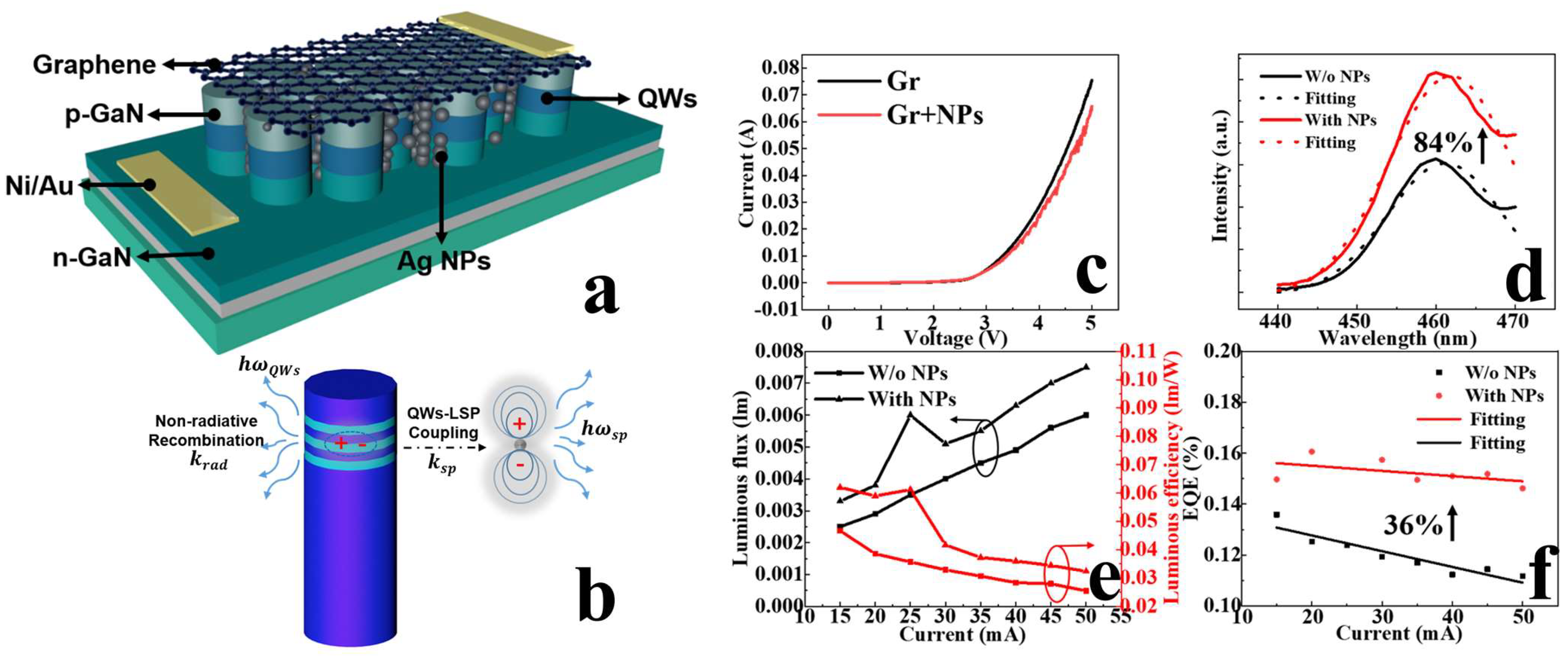
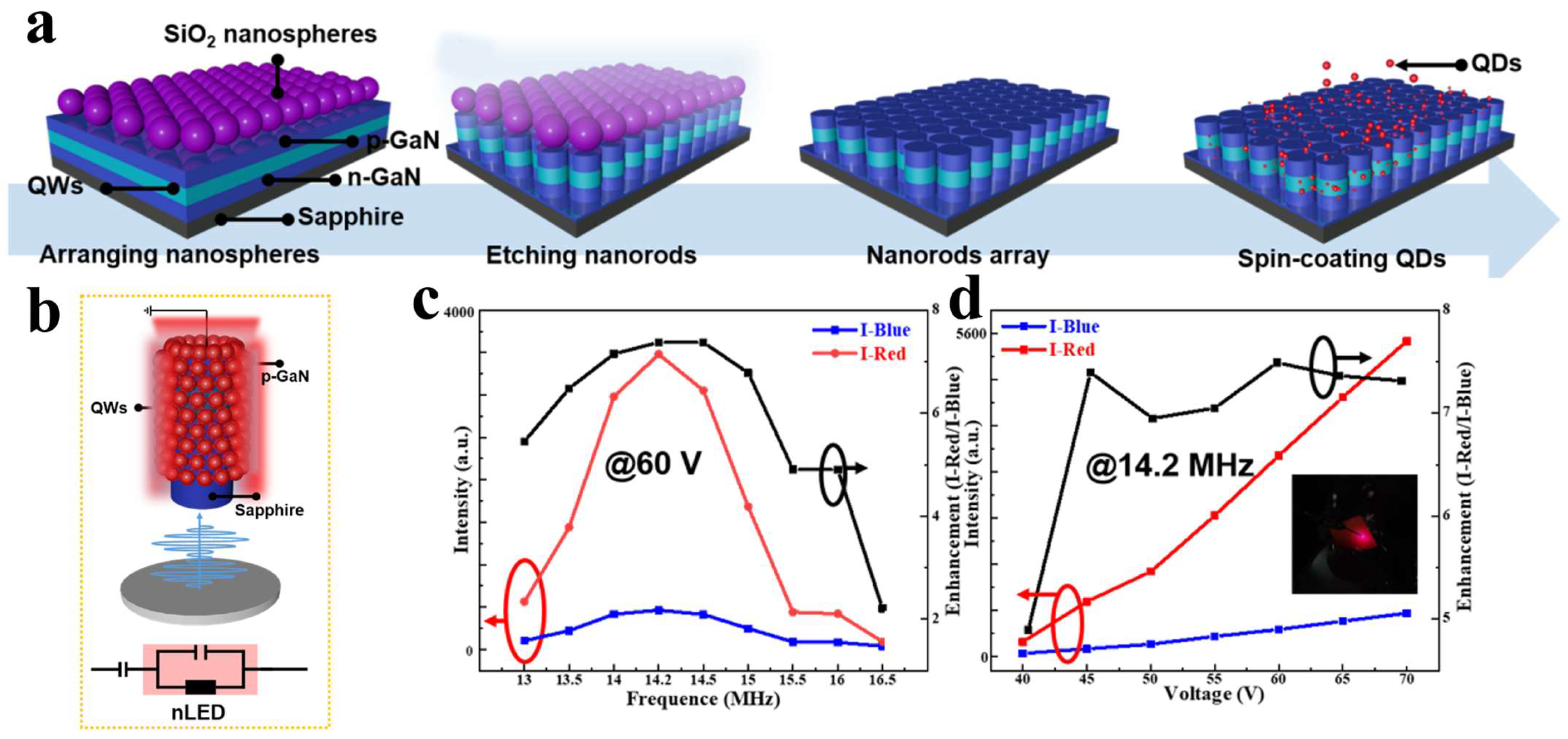
| Sample | NP | QW PL Decay Time (ns) | QD PL Decay Time (ns) |
|---|---|---|---|
| R | – | 1.84 | – |
| QD | – | 2.21 | 7.76 |
| QD-NP420 | Ag | 2.07 | 5.08 |
| QD-NP465 | Ag | 1.93 | 4.18 |
| QD-NP550 | Ag | 2.01 | 4.39 |
| QD-NP645 | Ag/Au shell | 2.14 | 5.83 |
Disclaimer/Publisher’s Note: The statements, opinions and data contained in all publications are solely those of the individual author(s) and contributor(s) and not of MDPI and/or the editor(s). MDPI and/or the editor(s) disclaim responsibility for any injury to people or property resulting from any ideas, methods, instructions or products referred to in the content. |
© 2024 by the authors. Licensee MDPI, Basel, Switzerland. This article is an open access article distributed under the terms and conditions of the Creative Commons Attribution (CC BY) license (https://creativecommons.org/licenses/by/4.0/).
Share and Cite
Fang, A.; Du, Z.; Guo, W.; Liu, J.; Xu, H.; Tang, P.; Sun, J. Advancements in Micro-LED Performance through Nanomaterials and Nanostructures: A Review. Nanomaterials 2024, 14, 940. https://doi.org/10.3390/nano14110940
Fang A, Du Z, Guo W, Liu J, Xu H, Tang P, Sun J. Advancements in Micro-LED Performance through Nanomaterials and Nanostructures: A Review. Nanomaterials. 2024; 14(11):940. https://doi.org/10.3390/nano14110940
Chicago/Turabian StyleFang, Aoqi, Zaifa Du, Weiling Guo, Jixin Liu, Hao Xu, Penghao Tang, and Jie Sun. 2024. "Advancements in Micro-LED Performance through Nanomaterials and Nanostructures: A Review" Nanomaterials 14, no. 11: 940. https://doi.org/10.3390/nano14110940





